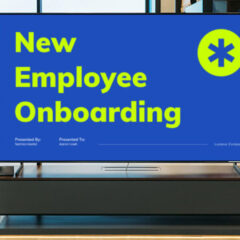Calling a Truce: Digital Signage Requires IT and Marketing to Work Together

Like a corporate version of the Hatfields and McCoys, the marketing and IT departments in many organizations are frequently involved in long-running feuds characterized by minimal levels of trust, support and collaboration. In an IBM survey, 60 percent of marketing executives cited a lack of alignment with the IT department as their single biggest obstacle to reaching consumers.
However, things are changing due to the rapid rise of digital technologies that require a great deal of cooperation among CIOs and CMOs. Nowhere is this more evident than in digital signage initiatives. Digital signage creates a unique intersection of the two entities, requiring both marketing’s creativity and IT’s technical expertise in order to reach potential customers, increase brand awareness and create new opportunities.
Retail organizations were among the first to utilize dynamic, interactive digital signs to reach customers and promote products, but use cases now cross all market boundaries. Hospitals, schools, airports, museums, banks and more are using the technology for wayfinding, announcements, event schedules and other applications.
Digital signage is one element of a rapidly expanding category of technologies for performing marketing activities. To illustrate the growing significance of these technologies, consider that CMOs are now spending more on marketing technology — or MarTech — than on staff salaries. According to a recent Gartner survey, marketing organizations spent 29 percent of their 2018 budgets on technology, compared to 24 percent on payroll.
This convergence of technology and marketing is challenging old stereotypes. Marketers have long viewed IT as a support organization rather than a strategic partner and chafed at slow responses to project requests. IT, meanwhile, considered marketing as a superfluous organization that contributed little to the bottom line and had little understanding of IT imperatives around data integration and security.
Digital signage is forcing both sides to reconsider their differences. Effective initiatives require finely tuned hardware and software resources as well as carefully crafted messaging.
Enterprise-grade digital signage requires some heavy lifting by the IT department. These systems feature high-definition flat-panel displays, authoring consoles, media servers and content management systems — all of which are connected to the network infrastructure.
Given the significant bandwidth requirements, these systems can disrupt or slow the performance of other business applications if the network isn’t up to the task. Delivery over WAN connections to remote or branch offices requires special considerations. Additionally, IT is responsible for properly monitoring, managing and maintaining the equipment.
While software, hardware, networking and cabling components are fundamental elements of a signage solution, none of it matters much if the messaging doesn’t resonate with the intended audience. Stale, uninspired messaging with misspellings, poor grammar and punctuation errors can leave customers with a poor impression.
That’s where the marketing team’s expertise is required. Using current customer data, the marketing team must create a library of eye-catching visuals and targeted messaging to boost customer engagement. Marketing professionals can also create an editorial calendar to establish the timing and coordination of messaging. One of the great benefits of digital signage is the ability to quickly and efficiently update, modify and rotate messaging.
Although marketing and IT organizations have traditionally had very different roles in the corporate structure, the rise of MarTech solutions such as digital signage compels them to call a truce and harness their efforts and expertise. Effective digital signage requires these teams to work together to develop an overall strategy, an implementation plan, and targeted messaging that can drive growth and profitability.
More Insights
-
Digital Experiences, SageVIEW Approach
How Digital Signage Boosts Workforce Productivity
-
Digital Experiences
How Digital Signage Can Play a Role in Reducing Workplace Stress
-
Digital Experiences
7 Steps for Upgrading and Enhancing a Digital Signage Network
-
Digital Experiences
Why You Should Make Digital Signage Security a High Priority




